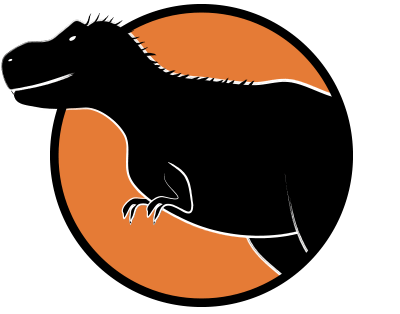Ask a Scientist: T. rex – Why Are the Arms and Fingers of T. rex So Small?
On-screen text: Arms and Fingers
Scene change to a cartoon illustration of a man with glasses, who begins to speak.
MARK NORELL: The arms of T. rex are tiny.
Cartoon drawing of a T. rex showing tiny arms.
NORELL: In fact, they're so tiny they couldn't even touch each other when the animal was alive.
Cartoon animation of Dr. Norell.
NORELL: These small arms couldn't even touch its mouth.
Cartoon drawing of a T. rex trying to touch its mouth.
NORELL: They're probably just an evolutionary artifact. They're vestigial and they're being evolved out…
T. rex’s small arms shrink into nothing.
NORELL: …because certainly, more primitive tyrannosaurs have typically much longer arms.
Cartoon drawing of different types of dinosaurs with longer arms than the T. rex.
NORELL: These primitive tyrannosaurs also have the typical number of digits on their hand.
The dinosaurs’ hands are circled in red.
NORELL: They have three fingers, just like modern birds do.
Line drawing of a wing with three bones that correspond to fingers highlighted in red.
NORELL: Tyrannosaurus rex has only two fingers.
Cartoon animation of Dr. Norell.
NORELL: Again, this is just a suggestion that these features are being evolved out. Originally, in 1915, when the 5027 specimen was put on display, that the arm sported three fingers.
Old photo of a T. rex skeleton on display, with on screen text: AMNH T.rex No. 5027. The three fingers of its hand are circled in red.
Cartoon animation of Dr. Norell.
NORELL: It wasn't until much later discoveries that it was determined that Tyrannosaurus rex only had two fingers, at that point, that the mount was modified to reflect this new research.
Image of T. rex skeleton with two fingers highlighted and circled in red.
On screen credits:
Executive Producer: AMNH/V. Trakinski
Editorial Producer: AMNH/L. Moustakerski
Editor: AMNH/J. Morfoot
Narrator/ Scientific Advisor: AMNH/M. Norell
Animator: AMNH/S. Krasinski
Images: AMNH, PNSO/Zhao Chuang
Ask a Scientist: T. rex – How Powerful Was the Bite of a T. rex?
On-screen text: Bite Force
Scene change to a cartoon illustration of a man with glasses, who begins to speak.
MARK NORELL: We can do mechanical experiments to predict the bite force of T. rex.
Animated T. rex skulls appear on either side of Dr. Norell and slam their jaws shut. The screen shakes with their CRUNCH.
NORELL: It's amazingly high, higher than any living animal on the order of around 7,000, 8,000 pounds.
Cartoon illustration of three cars stacked on top of each other, with on screen text: The weight of three cars.
NORELL: A bite force this large doesn't really cut through things. It causes bones to explode.
Cartoon illustration of exploding bone.
Cartoon animation of Dr. Norell.
NORELL: To calculate bite force, it's a combination of using mathematical and mechanical models.
On screen text: X + Y= Bones Explode
Cartoon animation of Dr. Norell.
NORELL: The best living analog for looking at bite force in animals like Tyrannosaurus rex is to study other big carnivorous reptiles, notably crocodilians…
Cartoon illustration of a crocodile biting down, with a first prize blue ribbon.
NORELL: … which exert some of the greatest bite forces that we know of on the planet today.
On screen credits:
Executive Producer: AMNH/V. Trakinski
Editorial Producer: AMNH/L. Moustakerski
Editor: AMNH/J. Morfoot
Narrator/ Scientific Advisor: AMNH/M. Norell
Animator: AMNH/S. Krasinski
WHAT'S SO SPECIAL ABOUT T. REX TEETH?
MARK NORELL: Like most other reptiles and all dinosaurs, Tyrannosaurus rex lost its teeth as it grew. Teeth would be worn down. Teeth would break. And a new one would take its place. One of the really amazing things about Tyrannosaurus rex teeth is that less than a third of the tooth is actually exposed. The rest of the tooth is composed of the root. And because of the tremendous bite force and the bone crushing habits that this animal had, the teeth had to have very, very, very strong anchors inside the jaws able to support these bite forces.
Ask a Scientist: T. rex – What Did T. rex Eat?
On-screen text: Eating Habits
Scene change to an illustration of T. rex with mouth open and wispy feathers along its back.
MARK NORELL: T. rex was a mega carnivore.
Image of a coprolite—a lumpy, rock-like object in a plaster cast. On-screen text: Fossil poop.
NORELL: We know this because we found fossil excrement, coprolites, which contain big bone fragments.
Cartoon animation of Dr. Norell—a man with glasses in a blazer.
NORELL: So, this indicates that when the animal bit something, the bones explosively blew up, that it would eat the entire thing, big chunks of muscle mass and bone all in one gulp.
On-screen text: Big gulp.
NORELL: We also know this because that there's been a few fossils found…
Image of a fossil bone in a museum. A tooth embedded in the bone is highlighted by a circle. The silhouette of an Edmontosaurus appears—a dinosaur with a long tail and duck-like bill.
NORELL: notably an Edmontosaurus tail, a duck-billed dinosaur, that has a broken T. rex tooth embedded in it with healing around it, indicating that this animal survived an attack.
Cartoon animation of Dr. Norell.
NORELL: Several years ago, there was something made about whether Tyrannosaurus rex was a scavenger or a predator.
The words “Scavenger” and “Predator” appear on-screen with checkboxes..
NORELL: This is really a false argument.
Cartoon animation of Dr. Norell.
NORELL: Certainly we know from fossils like the Edmontosaurus that it hunted living animals. But certainly, from studies of living animals today, living carnivorous animals,
Animated illustration of a T. rex investigating a dead dinosaur.
NORELL: …nothing's going to pass up a free meal if there's just a dead herbivore lying there.
Cartoon animation of Dr. Norell.
NORELL: As far as T. rex's hunting strategy is concerned, we feel strongly that it was an ambush predator. It would be very difficult to imagine it being a courser, like a cheetah.
Image of a cheetah in grasslands.
Cartoon animation of Dr. Norell.
NORELL: Because energetically, it would be really hard to sustain a long pursuit if you weigh as much as the tyrannosaur did.
On screen credits:
Executive Producer: AMNH/V. Trakinski
Editorial Producer: AMNH/L. Moustakerski
Editor: AMNH/J. Morfoot
Narrator/ Scientific Advisor: AMNH/M. Norell
Animator: AMNH/S. Krasinski
Images: AMNH/R. Peterson, Black Hills Institute of Geological Research, Make It Kenya Photo/Stuart Price, USGS/Karen Chin
Ask a Scientist: T. rex – Was T. rex Really Heavy?
On-screen text: Muscle
Scene change to an illustration of a massive T.rex, covered in wispy, quill-like feathers.
MARK NORELL: T. rex looks like a massive, massive animal. It was.
Different close-ups of the T. rex illustration, all with the word “MASSIVE” next to the animal. Then the word “YES!” next to the T. rex’s face.
Scene change to a cartoon illustration of a man with glasses, who begins to speak.
NORELL: It had a lot of volume, but it wouldn't weigh as much as you would think. A good example of this…
Illustration of balance scales with a chicken on one side and a puppy on the other side.
NORELL: …is that if you take a chicken, a live chicken, and you take a puppy, they both have the same volume, but the puppy weighs three or four times as much.
At first the scales are balanced, but then the side with the puppy dips down, indicating a heavier weight.
Cartoon animation of Dr. Norell.
NORELL: And that's because the chicken is full of air. Its bones are hollow.
Illustration of a chicken with air sacs indicated throughout its body.
NORELL: It had big air sacs.
Cartoon animation of Dr. Norell.
NORELL: We know from looking at the bones of T. rex, it also would have had big air sacs.
Illustration of a T.rex with large air sac indicated in the middle of its body and a smaller one just above its arms.
NORELL: Crocodiles even have big air sacs…
Cartoon animation of Dr. Norell.
NORELL: …and certainly living birds do. So, while it looks really big…
Illustration of weight scales, with a T.rex on one side and an elephant on the other side. The elephant tips the scales. Text on the T. rex reads: 6 tons. Text on the elephant reads: 12 tons.
NORELL: …it wouldn't weigh the same as an elephant.
On-screen credits:
Executive Producer: AMNH/V. Trakinski
Editorial Producer: AMNH/L. Moustakerski
Editor: AMNH/J. Morfoot
Narrator/ Scientific Advisor: AMNH/M. Norell
Animator: AMNH/S. Krasinski
Images: AMNH/ R.Peterson
Ask a Scientist: T. rex – How Fast Did T. rex Move?
On-screen text: Legs
Scene change to a cartoon illustration of a T. rex.
MARK NORELL: The Tyrannosaurus rex had incredibly powerful legs.
Cartoon animation of Dr. Norell—a man with glasses in a blazer.
NORELL: Its absolute speed, we don't know for sure…
Animation of a T. rex skeleton running, with a speedometer showing 20mph.
NORELL: …but some informed estimates based on simulation have suggested it could go about 20 miles an hour. This is pretty fast. I mean, it's faster than we can run, but it probably couldn't do this over an extended time period.
Cartoon animation of Dr. Norell.
NORELL: Tyrannosaurus rex was an ambush predator, so it was more of a sit and wait predator, kind of like an African lion.
Image of a female lion sitting on grass.
Cartoon animation of Dr. Norell.
NORELL: Something would get close, it could move with a lot of speed over a short distance…
Animation of T. rex skeleton legs walking towards the camera.
NORELL: …and dispatch its prey.
On-screen credits:
Executive Producer: AMNH/V. Trakinski
Editorial Producer: AMNH/L. Moustakerski
Editor: AMNH/J. Morfoot
Narrator/ Scientific Advisor: AMNH/M. Norell
Animator: AMNH/S. Krasinski
Images: AMNH/L. Kushner, University of Oregon / Kent A. Stevens
Ask a Scientist: T. rex – How Did T. rex Stand?
On-screen text: Godzilla.
Old photo of T. rex skull. On-screen text: AMNH T. rex, No. 5027.
MARK NORELL: The 5027 T. rex specimen was first put on display at the American Museum of Natural History in 1915.
Scene change to a cartoon illustration of Dr. Norell—a man with glasses, in a blazer.
NORELL: The skeleton was mounted sort of in what we call a Godzilla pose…
A doodle illustration of a dragon-like monster standing on its hind feet and blowing fire appears next to Dr. Norell.
NORELL: standing up with its backbone near vertical, and its tail dragging behind it.
Old photos of the upright T. rex skeleton on display at the American Museum of Natural History.
NORELL: One of my first tasks when I came to the Museum was to work on the redevelopment of the dinosaur halls here.
Time lapse footage of workers re-assembling the T. rex in the Museum’s Saurischian Dinosaur Hall with scaffolding and ladders. Text labels the year as 1992.
NORELL: During that time, we decided that we were going to remount the Tyrannosaurus rex in a much more anatomically accurate position. We really have learned a lot since 1915 when the first one was put on display, so instead of looking like a big kangaroo with a dragging tail…
Photo of the complete T. rex skeleton on display at the Museum with an anatomically correct posture.
NORELL: …it has much more of a birdlike posture with an S-shaped neck, with its backbone held parallel to the ground, and a long tail extending behind it acting as a counterweight to the front of the body.
Animated lines trace out the S-shaped neck, the line of the spine, and the long tail.
On-screen credits:
Executive Producer: AMNH/V. Trakinski
Editorial Producer: AMNH/L. Moustakerski
Editor: AMNH/J. Morfoot
Narrator/ Scientific Advisor: AMNH/M. Norell
Animator: AMNH/S. Krasinski
Images: AMNH
Ask a Scientist: T. rex – How Did T. rex Sit?
On-screen text: The Pubic Boot
Scene change to a cartoon illustration of a man with glasses, who begins to speak.
MARK NORELL: We've never really found a T. rex impression of where it was lying down, however, all dinosaurs, or all saurischian dinosaurs rather…
Rendering of T. rex skeleton with pubic bone highlighted between its legs.
NORELL: …have a large pubic boot.
Animated T. rex skeleton sits down. Its pubic bone is highlighted to show the skeletal configuration as it sits.
NORELL: So that there is absolutely no reason that they couldn't sit down in place, or perhaps even on top of a nest.
Cartoon animation of Dr. Norell—a man with glasses in a blazer.
NORELL: Some other dinosaurs that have pubic boots, albeit much smaller…
Photo of a fossilized dinosaur nest, showing the remains of a dinosaur sitting on a nest of eggs.
NORELL: …we do have direct fossil evidence of them sitting down, brooding their nests of eggs.
The fossilized eggs are highlighted in the nest.
On-screen credits:
Executive Producer: AMNH/V. Trakinski
Editorial Producer: AMNH/L. Moustakerski
Editor: AMNH/J. Morfoot
Narrator/ Scientific Advisor: AMNH/M. Norell
Animator: AMNH/S. Krasinski
Images: AMNH/ M.Ellison, University of Oregon/ Kent A. Stevens
Ask a Scientist: T. rex – Did T. rex Lay Eggs?
On-screen text: Eggs and Nests
Scene change to a cartoon illustration of a man with glasses, who begins to speak.
MARK NORELL: We haven't found yet a Tyrannosaurus rex nest or identified any of its eggs.
On screen text: Archosaurs: dinosaurs, birds & crocs. Cladogram shows the relationships of archosaurs: dinosaurs, birds, and crocodiles.
NORELL: However, since all archosaurs, crocodiles and birds, lay eggs…
Bird at top of cladogram and crocodile at bottom are circled in red.
NORELL: …and we know lots of other different dinosaurs also laid eggs…
Silhouettes of two different dinosaurs and text reading: Egg-O-Saurs. Eggs drop out of both.
NORELL: …we can infer the Tyrannosaurus rex also laid eggs.
Illustration of cartoon T. rex dropping an egg.
Cartoon animation of Dr. Norell.
NORELL: The evidence that we have so far indicates that theropod dinosaurs laid their eggs in nests.
Cartoon illustration of eggs arranged around the inner arc of a circular nest.
NORELL: These eggs were carefully arranged reflecting one egg each day from each oviduct, so the eggs are laid in pairs. While we don't have any direct evidence from Tyrannosaurus rex…
Archival image of excavated dinosaur eggs, arrayed in an arc.
NORELL: …we do from other theropod dinosaurs that are closely related to it, so we think that this is probably stereotypical of this group.
Cartoon animation of Dr. Norell.
NORELL: We also don't know whether or not the T. rex brooded its eggs or whether it protected its nest.
Image of fossilized dinosaur nest.
NORELL: We do know that closely related animals did brood their nests.
Cartoon animation of Dr. Norell.
NORELL: And we know from both birds and crocodiles that archosaurs are pretty good at protecting their nests as well.
Cartoon T. rex stands guard over a nest mound with eggs.
NORELL: So, we can make a strong inference that T. rex would have guarded its nest.
On-screen credits:
Executive Producer: AMNH/V. Trakinski
Editorial Producer: AMNH/L. Moustakerski
Editor: AMNH/J. Morfoot
Narrator/ Scientific Advisor: AMNH/M. Norell
Animator: AMNH/M. Ellison, AMNH/J. B. Shackelford
Ask a Scientist: T. rex – Did T. rex Have a Wishbone?
On-screen text: Wishbone
Scene change to cartoon illustration of a wishbone in a chicken, animation demonstrating placement in the chicken’s anatomy—just below its throat at the top of its breast.
MARK NORELL: Wishbones are familiar elements to anyone who eats chickens today, but surprisingly, Tyrannosaurus Rex and most other theropod dinosaurs also have this same structure.
Camera pulls back to reveal a cartoon T. rex walking behind the chicken. Its wishbone is circled to demonstrate placement. Similar to the chicken, it is at the top of the breast (just below its tiny arms).
Cartoon animation of Dr. Norell—a man with glasses in a blazer.
NORELL: Its use in living birds has to do with making the petrol girdle much more solid, allowing for powered flight.
Animation of a flying bird with wishbone highlighted in white.
Illustration of a T. rex, its wishbone surrounded by question marks.
NORELL: Its function in animals like Tyrannosaurus rex is largely unknown.
On-screen credits:
Executive Producer: AMNH/V. Trakinski
Editorial Producer: AMNH/L. Moustakerski
Editor: AMNH/J. Morfoot
Narrator/ Scientific Advisor: AMNH/M. Norell
Animator: AMNH/S. Krasinski
Images/ Sound Effects: AMNH/ R. Peterson






 Biodiversity
Biodiversity
 Brain
Brain
 Genetics
Genetics
 Marine BiOLogy
Marine BiOLogy
 MicrobiOLogy
MicrobiOLogy
 PaleontOLogy
PaleontOLogy
 ZoOLogy
ZoOLogy
 AnthropOLogy
AnthropOLogy
 ArchaeOLogy
ArchaeOLogy
 Astronomy
Astronomy
 Climate Change
Climate Change
 Earth
Earth
 Physics
Physics
 Water
Water
